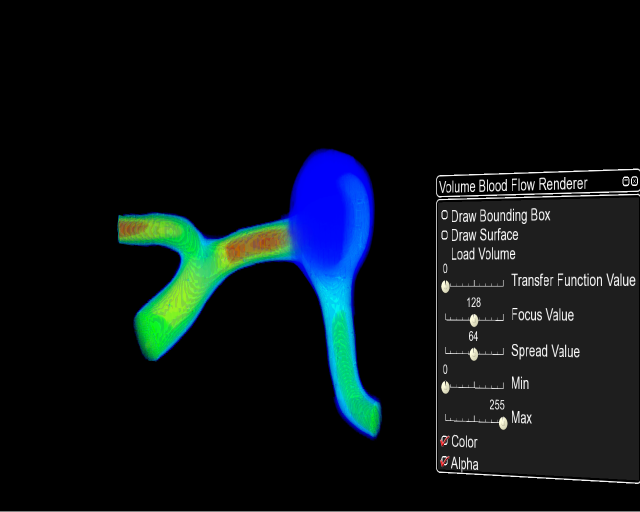Volumetric Blood Flow Rendering
From Immersive Visualization Lab Wiki
The Volume Bloodflow project is a collaboration with the school of structural engineering and CalIT2, where we attempt to use the StarCAVE to visualize blood flow in blood vessels, for medical purposes.
Blood flow in blood vessels are simulated by faculty in the structural engineering department, and the simulation results are output in an unstructured tetrahedral format. This data is then parsed and interpolated, and stored in an octree format. It is then rendered using slice based volume rendering techniques, with interactive pixel shader implemented transfer functions. Animation of an entire heartbeat can be easily visualized, improving analysis of the flow and ease of identifying areas of interest.
Contents |
Members
- Current graduate students: Ming-Chen Hsu, Han Kim, and Gregory Long
- Faculty: Yuri Bazilevs, Jurgen Schulze, and Alison Marsden
- Past students: Kenneth Benner, Sasha Koruga
Current Project Status
- Octree representation has been completed
- Wireframe surface outline is being drawn
- Slice rendering direction is changed inside the vessel, to reduce the amount of artifacts seen
- A more interactive transfer function has been added, using pixel shaders
- Animations now work
TODO
- Fix the problem with textures needing to load in the first pass of the program
- Try to find more optimizations for large datasets
- Clean up the code
- Finalize documentation
Media
Paper List
Cylindrical rendering
- Colon Visualization Using Cylindrical Parameterization - Z. Mai, T. Huysmans, and J. Sijbers
- Volumetric Rendering of Cylindrical data
- http://portal.acm.org/citation.cfm?id=99318
- talks about rendering curvilinear surfaces, basically just says to interpolate
Flow Visualization
- Illustrative Stream Surfaces - Silvia Born, Alexander Wiebel, Jan Friedrich, Gerik Scheuermann, and Dirk Bartz
- this paper has amazing illustrative figures of vector fields.
- Evenly Spaced Streamlines for Surfaces: An Image-Based Approach
- Flow Visualization Techniques for CFD Using Volume Rendering https://e-reports-ext.llnl.gov/pdf/238449.pdf
- Nice overview of different flow visualization techniques (streamlines, stream surfaces, etc)
- Flow http://www.zhanpingliu.org/research/flowvis/FlowVis.htm
- overview of many flow visualization techniques - focuses on Line Integral Convolution and extensions of it.
Transfer function
- Semi-Automatic Time-Series Transfer Functions via Temporal Clustering and Sequencing
- An Exploratory Technique for Coherent Visualization of Time-varying Volume Data http://onlinelibrary.wiley.com/doi/10.1111/j.1467-8659.2009.01690.x/abstract
- Importance-driven time-varying data visualization http://ieeexplore.ieee.org/stamp/stamp.jsp?tp=&arnumber=4658174
System
- Real-time decompression and visualization of animated volume data
- Texture hardware assisted rendering of time-varying volume data
- A fast volume rendering algorithm for time-varying fields using a time-space partitioning tree.
- Volume Rendering of Abdominal Aortic Aneurysms Roger C. Tam, Christopher G. Healey, Borys Flak, and Peter Cahoon
- http://www.csc.ncsu.edu/faculty/healey/HTML_papers/aneurism/aneurism.html
- old, specific to topic, on whole CT data, not a model
- Computer aided diagnosis for virtual endoscopy Wei Hong
- http://portal.acm.org/citation.cfm?id=1570930&coll=DL&dl=GUIDE&CFID=4717818&CFTOKEN=19743614
- no online copy available
- not specific to blood vessels
- High-Quality Two-Level Volume Rendering of Segmented Data Sets on Consumer Graphics Hardware
- http://portal.acm.org/citation.cfm?id=1081432.1081484&coll=DL&dl=GUIDE&CFID=4717818&CFTOKEN=19743614
- emphasizes implementation of the rendering
Segmentation
- Hybrid Segmentation and Exploration of the Human Lungs
- http://portal.acm.org/citation.cfm?id=1081432.1081468&coll=DL&dl=GUIDE&CFID=4717818&CFTOKEN=19743614
- rendering lungs for virtual endoscopy
- segmentation methods
- touches on blood vessels in lungs - too small/intricate?
- Connectivity-based local adaptive thresholding for carotid artery segmentation using MRA images
- link
- seems relevant, no pdf
Vector field visualization
- Most vector field visualization are textures, “smoke” particles
- mostly seems to apply to fluids passing over solid objects (cars, airplanes)
- Visualization of Vorticity and Vortices in Wall-Bounded Turbulent Flows
- Higher Dimensional Vector Field Visualization: A Survey
- http://cs.swansea.ac.uk/~cszp/files/peng09survey/peng09survey.pdf
- summary of different techniques
- current (2009)
- looked mostly at section 4, 5 & the table at the beginning
